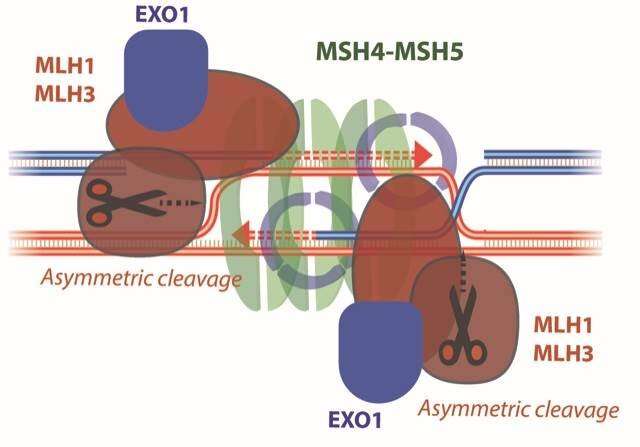Credit: Nature
Reconstitution of the activation of the MLH1–MLH3 endonuclease shows how crossovers are formed during meiosis.
When DNA breaks, cells use the homologous recombination pathway to accurately repair the break, so that DNA is fixed and no mutations are introduced during the repair process. When multiple DNA molecules are broken, the recombination factors use a smart strategy to join only the DNA pieces originating from the same DNA molecules. This is very important, because mistakes in this process can lead to uncontrolled growth and tumor formation. Therefore, the recombination machinery has evolved to be remarkably precise.
In contrast, in specialized cells undergoing meiotic division, which includes spermatocytes and oocytes in humans, the homologous recombination has a different purpose. Meiotic cells induce DNA breaks deliberately, and use recombination to mix and match the DNA sequences between chromosomes coming from the previous generation (mum and dad). Like this, the organisms achieve new combination of genes, which did not exist before. Such a diversity is one of the drivers of evolution. The mix-matched genetic outcome is therefore almost the exact opposite to what happens in most other (non-meiotic) cells.
How can one pathway (homologous recombination) achieve such different outcomes? The answer is that the proteins that function in recombination in meiotic and non-meiotic cells are in part different. Specifically, a group of proteins, centered around the MLH1-MLH3 complex, function specifically in meiotic recombination. MLH1-MLH3, as well as MSH4-MSH5 and were found to be important for such a mix-matching of DNA—termed crossover formation. How exactly this happens was however not clear, and has been a long-standing interested of the Cejka laboratory at the Institute for Research in Biomedicine.
When recombination repairs broken DNA, the intermediates of the repair process are termed joint-molecules, structures that link both broken and not-broken DNA molecules. The trick, it seems, is how to cut these structures. Normal cells use strategies that separate the joint molecules in a way that the original composition is restored. Meiotic cells, instead, use MLH1-MLH3 to cut DNA in a way that produces the mix-matched DNA. A recent study from the Cejka laboratory at the Institute for Research in Biomedicine (IRB, affiliated to USI Università della Svizzera italiana), published in the journal of Nature Research, describes a possible mechanism for this DNA cleavage. Elda Cannavo, Aurore Sanchez and Roopesh Anand, the main authors of the study that carried out the experimental work, demonstrated that the DNA cleavage by MLH1-MLH3 is directed by a ring-like protein PCNA. PCNA is needed for DNA synthesis during recombination, and as DNA is synthesized on only one strand of the break, its asymmetric presence at the joint molecule recombination intermediates directs MLH1-MLH3 to cleave DNA in the configuration that produces crossovers.
Mutations in MLH1-MLH3 and associated factors lead to sterility in humans.
More information: Elda Cannavo et al. Regulation of the MLH1–MLH3 endonuclease in meiosis, Nature (2020). DOI: 10.1038/s41586-020-2592-2
Journal information: Nature
Provided by Università della Svizzera italiana
























